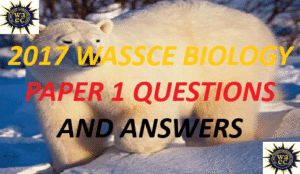Enlighten knowledge exam, Sample essay question on cell cycle and cell division, (elective biology SHS).
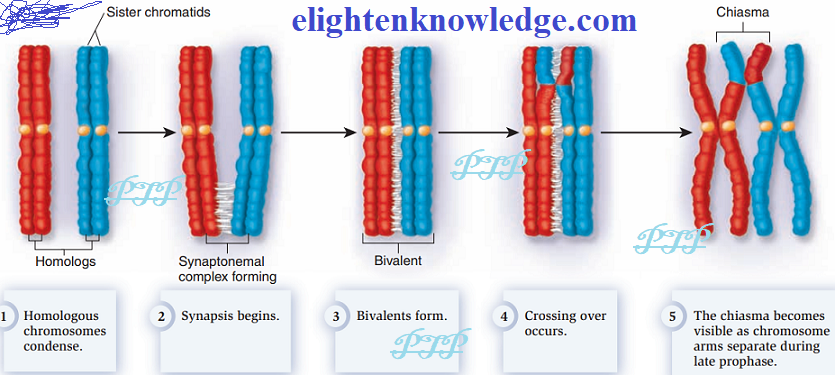
What are the four stages of the cell cycle? During which of these stages is the DNA replicated, and when does cell division occur?
The four stages of the cell cycle are;
- G1 stage.
- S stage.
- G2 stage.
- M stage.
- DNA is replicated during the S stage.
- Cell division occurs during the M stage.
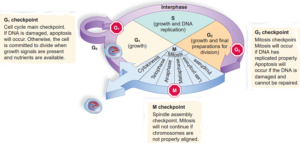
The cell cycle.
Briefly describe the events that occur in each phase of interphase.
During G1,
- The cell increases in size, the genomic DNA is assessed for damage, and the cell stockpiles energy reserves and the components to synthesize DNA.
During the S phase,
- The chromosomes, the centrosomes, and the centrioles (animal cells) duplicate.
During the G2 phase,
- The cell recovers from the S phase, continues to grow, duplicates some organelles, and dismantles other organelles.
What conditions might cause a cell to halt the cell cycle?
- DNA damage
- Failure to properly replicate the DNA
- Failure of chromosomes to attach properly to spindle
What are the major events that occur during prophase, and why are these events important to the process of cell division?
During prophase;
- The nuclear membrane fragments
- The nucleus disappears
- The chromosomes condense, and the spindle begins to form.
- Without these events, mitosis could not occur.
How does cytokinesis differ between animal and plant cells? Why is this difference necessary?
- Animal cells furrow and plant cells have a cell plate.
- Because plant cells have rigid cell walls, they cannot furrow
What are the major characteristics of cancer cells that distinguish them from normal cells?
- Cancer cells lack differentiation
- They have abnormal nuclei.
- They also fail to undergo apoptosis.
- May also form tumors,
- Undergo angiogenesis.
- May also metastasize throughout the body.
How does binary fission in prokaryotes differ from mitosis and cytokinesis in eukaryotes?
- Binary fission involves inward growth of plasma membrane and cell wall concomitant with the separation of the duplicated chromosome attached to the plasma membrane.
- Mitosis always involves a mitotic spindle to distribute the daughter chromosomes.
How are prokaryotic and eukaryotic chromosomes different?
- Prokaryotes usually have a single, small circular chromosome with a few genes and only a few associated proteins.
- Eukaryotes have many long, linear chromosomes, which contain many thousands of genes and many more proteins.
Compare and contrast a human somatic cell to a human gamete.
- Human somatic cells have 46 chromosomes: 22 pairs and 2 sex chromosomes that may or may not form a pair. This is the 2n or diploid condition.
- Human gametes have 23 chromosomes, one each of 23 unique chromosomes, one of which is a sex chromosome. This is the n or haploid condition.
What is the relationship between a genome, chromosomes, and genes?
- The genome consists of the total of an organism’s chromosomes.
- Each chromosome contains hundreds and sometimes thousands of genes, segments of DNA that code for a polypeptide or RNA, and a large amount of DNA with no known function.
Eukaryotic chromosomes are thousands of times longer than a typical cell. Explain how chromosomes can fit inside a eukaryotic nucleus.
- The DNA double helix is wrapped around histone proteins to form structures called nucleosomes.
- Nucleosomes and the linker DNA in between them are coiled into a 30-nm fiber.
- During cell division, chromatin is further condensed by packing proteins.
Describe the process that results in the formation of a tetrad.
- During the meiotic interphase, each chromosome is duplicated.
- The sister chromatids that are formed during synthesis are held together at the centromere region by cohesin proteins.
- All chromosomes are attached to the nuclear envelope by their tips.
- As the cell enters prophase I, the nuclear envelope begins to fragment, and the proteins holding homologous chromosomes locate each other.
- The four sister chromatids align lengthwise, and a protein lattice called the synaptonemal complex is formed between them to bind them together.
- The synaptonemal complex facilitates crossover between non-sister chromatids, which is observed as chiasmata along the length of the chromosome.
- As prophase I progresses, the synaptonemal complex breaks down and the sister chromatids become free, except where they are attached by chiasmata.
- At this stage, the four chromatids are visible in each homologous pairing and are called a tetrad.
Explain how the random alignment of homologous chromosomes during metaphase I contributes to the variation in gametes produced by meiosis.
- Random alignment leads to new combinations of traits.
- The chromosomes that were originally inherited by the gamete-producing individual came equally from the egg and the sperm.
- In metaphase I, the duplicated copies of these maternal and paternal homologous chromosomes line up across the center of the cell.
- The orientation of each tetrad is random.
- There is an equal chance that the maternally derived chromosomes will be facing either pole.
- The same is true of the paternally derived chromosomes.
- The alignment should occur differently in almost every meiosis.
- As the homologous chromosomes are pulled apart in anaphase I, any combination of maternal and paternal chromosomes will move toward each pole.
- The gametes formed from these two groups of chromosomes will have a mixture of traits from the individual’s parents. Each gamete is unique.
What is the function of the fused kinetochore found on sister chromatids in prometaphase I?
- In metaphase I, the homologous chromosomes line up at the metaphase plate.
- In anaphase I, the homologous chromosomes are pulled apart and move to opposite poles.
- Sister chromatids are not separated until meiosis II.
- The fused kinetochore formed during meiosis I ensure that each spindle microtubule that binds to the tetrad will attach to both sister chromatids.
In a comparison of the stages of meiosis to the stages of mitosis, which stages are unique to meiosis, and which stages have the same events in both meiosis and mitosis?
- All of the stages of meiosis I, except possibly telophase I, are unique because homologous chromosomes are separated, not sister chromatids.
- In some species, the chromosomes do not decondense and the nuclear envelopes do not form in telophase I.
- All of the stages of meiosis II have the same events as the stages of mitosis, with the possible exception of prophase II.
- In some species, the chromosomes are still condensed and there is no nuclear envelope.
- Other than this, all processes are the same.
Chemotherapy drugs such as vincristine and colchicine disrupt mitosis by binding to tubulin (the subunit of microtubules) and interfering with microtubule assembly and disassembly. Exactly what mitotic structure is targeted by these drugs and what effect would that have on cell division?
- The mitotic spindle is formed of microtubules.
- Microtubules are polymers of the protein tubulin; therefore, it is the mitotic spindle that is disrupted by these drugs.
- Without a functional mitotic spindle, the chromosomes will not be sorted or separated during mitosis.
- The cell will arrest in mitosis and die.
Describe the similarities and differences between the cytokinesis mechanisms found in animal cells versus those in plant cells.
- There are very few similarities between animal cell and plant cell cytokinesis.
- In animal cells, a ring of actin fibers is formed around the periphery of the cell at the former metaphase plate (cleavage furrow).
- The actin ring contracts inward, pulling the plasma membrane toward the center of the cell until the cell is pinched in two.
- In plant cells, a new cell wall must be formed between the daughter cells.
- Due to the rigid cell walls of the parent cell, contraction of the middle of the cell is not possible.
- Instead, a phragmoplast first forms.
- Subsequently, a cell plate is formed in the center of the cell at the former metaphase plate.
- The cell plate is formed from Golgi vesicles that contain enzymes, proteins, and glucose.
- The vesicles fuse and the enzymes build a new cell wall from the proteins and glucose.
- The cell plate grows toward and eventually fuses with the cell wall of the parent cell.
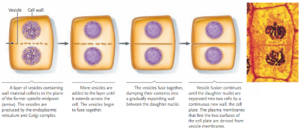
List some reasons why a cell that has just completed cytokinesis might enter the G0 phase instead of the G1 phase.
- Many cells temporarily enter G0 until they reach maturity.
- Some cells are only triggered to enter G1 when the organism needs to increase that particular cell type.
- Some cells only reproduce following an injury to the tissue. Some cells never divide once they reach maturity
What cell cycle events will be affected in a cell that produces mutated (non-functional) cohesin protein?
- If cohesin is not functional, chromosomes are not packaged after DNA replication in the S phase of interphase.
- It is likely that the proteins of the centromeric region, such as the kinetochore, would not form.
- Even if the mitotic spindle fibers could attach to the chromatids without packing, the chromosomes would not be sorted or separated during mitosis.
Describe the general conditions that must be met at each of the three main cell cycle checkpoints.
- The G1 checkpoint monitors adequate cell growth, the state of the genomic DNA, adequate stores of energy, and materials for the S phase.
- At the G2 checkpoint, DNA is checked to ensure that all chromosomes were duplicated and that there are no mistakes in newly synthesized DNA. Additionally, cell size and energy reserves are evaluated.
- The M checkpoint confirms the correct attachment of the mitotic spindle fibers to the kinetochores
Explain the roles of the positive cell cycle regulators compared to the negative regulators.
- Positive cell regulators such as cyclin and Cdk perform tasks that advance the cell cycle to the next stage.
- Negative regulators such as Rb, p53, and p21 block the progression of the cell cycle until certain events have occurred.
Outline the steps that lead to a cell becoming cancerous.
- If one of the genes that produce regulator proteins becomes mutated, it produces a malformed, possibly non-functional, cell cycle regulator, increasing the chance that more mutations will be left unrepaired in the cell.
- Each subsequent generation of cells sustains more damage.
- The cell cycle can speed up as a result of the loss of functional checkpoint proteins.
- The cells can lose the ability to self-destruct and eventually become “immortalized.
List and briefly describe the three processes that lead to variation in offspring with the same parents.
- Crossover occurs in prophase I between non-sister homologous chromosomes. Segments of DNA are exchanged between maternally derived and paternally derived chromosomes, and new gene combinations are formed.
- Random alignment during metaphase I lead to gametes that have a mixture of maternal and paternal chromosomes.
- Fertilization is random, in that any two gametes can fuse.
Compare the three main types of life cycles in multicellular organisms and give an example of an organism that employs each.
- In the haploid-dominant life cycle, the multicellular stage is haploid. The diploid stage is a spore that undergoes meiosis to produce cells that will divide mitotically to produce new multicellular organisms. Fungi have a haploid-dominant life cycle.
- In the diploid-dominant life cycle, the most visible or largest multicellular stage is diploid. The haploid stage is usually reduced to a single cell type, such as a gamete or spore. Animals, such as humans, have a diploid-dominant life cycle.
- In the alternation of generations life cycle, there are both haploid and diploid multicellular stages, although the haploid stage may be completely retained by the diploid stage. Plants have a life cycle with an alternation of generations.
What are the three interrelated systems that contribute to the eukaryotic cell cycle?
- An elaborate master program of molecular checks and balances ensures an orderly and timely progression through the cell cycle.
- The process of DNA synthesis replicates each DNA chromosome into two copies with almost perfect fidelity.
- A structural and mechanical web of interwoven “cables” and “motors” of the mitotic cytoskeleton separates the DNA copies precisely into the daughter cells.
What is the general composition of a eukaryotic chromosome?
- A linear DNA molecule complexed with proteins.
What is the role of histone H1 in eukaryotic chromosome structure?
- Histone H1 is responsible for the next level of chromo- some packing above the nucleosome.
- H1 binds to the exit/entry point of DNA on the nucleosome and to the linker DNA and brings about the coiling of the chromatin into the 30-nm chromatin fiber.
- The coiled structure is called the solenoid.
Compare the chromosome content of daughter cells following mitosis with that of the parent cell before its chromosomes were duplicated.
- Each daughter cell has the same number and types of chromosomes, and contains the same genetic information, as the parent cell before its chromosomes were duplicated.
In what order do the stages of mitosis occur?
- In order, the stages of mitosis are prophase, prometaphase, metaphase, anaphase, and telophase.
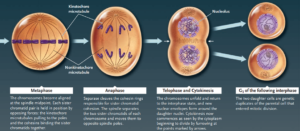
What is the importance of centromeres to mitosis?
- Each eukaryotic chromosome has a specialized region known as a centromere.
- The centromere is where a complex of several proteins, called a kinetochore, forms.
- During mitosis, some spindle microtubules attach to each kinetochore.
- These connections determine the outcome of mitosis because they attach the sister chromatids of each chromosome to microtubules leading to the opposite spindle poles; during anaphase, the spindle separates sister chromatids and pulls them to opposite spindle poles.
- In brief, the centromeres are key to chromosome segregation during mitosis.
- Although not mentioned in the chapter, this is also apparent when problems occur in which a chromosome fragment without a centromere breaks off from a chromosome.
- The fragment without a centromere cannot connect to the spindle and hence is not segregated properly.
Explain the difference between a proto-oncogene and a tumor suppressor gene.
- A proto-oncogene is a segment of DNA that codes for one of the positive cell cycle regulators.
- If that gene becomes mutated so that it produces a hyperactivated protein product, it is considered an oncogene.
- A tumor suppressor gene is a segment of DNA that codes for one of the negative cell cycle regulators.
- If that gene becomes mutated so that the protein product becomes less active, the cell cycle will run unchecked.
- A single oncogene can initiate abnormal cell divisions; however, tumor suppressors lose their effectiveness only when both copies of the gene are damaged.
Name the common components of eukaryotic cell division and binary fission.
The common components of eukaryotic cell division and binary fission are;
- DNA duplication
- Segregation of duplicated chromosomes
- Division of the cytoplasmic contents.
Describe how the duplicated bacterial chromosomes are distributed into new daughter cells without the direction of the mitotic spindle.
- As the chromosome is being duplicated, each origin moves away from the starting point of replication.
- The chromosomes are attached to the cell membrane via proteins; the growth of the membrane as the cell elongates aids in their movement.
How does spindle formation differ in animals and plants?
- In animal cells, all of which have centrosomes, the spindle forms through the division of the cell center.
- As the dividing centrosome separates into two parts, the microtubules of the spindle form between them.
- Plant cells lack centrosomes. In plant cells, the spindle microtubules simply assemble around the nucleus.
- In either case, the microtubules assemble in a parallel array that creates two poles in the dividing cell.
How do mitotic spindles move chromosomes?
- Chromosomes (sister chromatids) move apart during anaphase.
- During the anaphase movements, the kinetochores move along the kinetochore microtubules, which become shorter as the anaphase progresses.
- The non-kinetochore microtubules slide over each other, decreasing the degree of overlap and pushing the poles farther apart.
- The total distance traveled by the chromosomes is the sum of the two movements.
What is metastasis?
- Metastasis is when cells break loose from a tumor, spread throughout the body, and grow into new tumors in other body regions.
Define what is meant by a homologous pair of chromosomes.
- Homologous chromosomes are two copies of the same kind of chromosome, by length, size, and location of the centromere.
- Also, they contain genes for the same traits in the same order.
How does chromosome sorting in meiosis differ from mitosis?
- Homologous chromosomes pair during synapsis and then separate so each daughter cell receives one from each pair.
- During mitosis sister chromatids separate becoming daughter chromosomes so each daughter cell receives the same number and kinds of chromosomes as the parent cell.
Why are meiosis and sexual reproduction important in responding to the changing environment?
- Genetic variability ensures that at least some individuals have traits that will allow a species to survive adverse conditions.
What would cause certain daughter cells following meiosis II to be identical? What would cause them to not be identical?
- Two daughter cells that share the same parent cell from meiosis I are identical unless crossing-over occurred.
How does interkinesis differ from interphase?
- Interkinesis is the intervening cell cycle between meiotic divisions.
- It differs from interphase in that the stages of the cell cycle do not occur.
- The chromosomes are already duplicated
How do bacteria divide?
Present in eukaryotic cell division, but absent from bacterial cell division, are the following:
- The process of mitosis;
- Any form of microtubules for chromosome segregation;
- A spindle apparatus;
- Cyclin/CDK control proteins.
What processes involved in eukaryotic cell division are absent from bacterial cell division?
- Joined sister chromatid pairs attach to kinetochore microtubules during prometaphase and begin their migration to the metaphase plate.
- The spindle microtubules are also necessary for segregating the sister chromatids to opposite poles of the cell during anaphase.
- Colchicine would block spindle formation and no kinetochore microtubules would be present to attach to the sister chromatids.
- As a result, the cells would not be able to complete mitosis.
- In fact, colchicine is used to get cells to arrest in metaphase when the chromosomes are at their most condensed.
- At that stage, the chromosomes are the easiest to visualize by microscopy.
What is apoptosis?
- Apoptosis is a sequence of events that results in a fragmented cell. The fragments are phagocytized (engulfed) by white blood cells and neighboring tissue cells.






